Top>HAKUMON Chuo [2016 Early Spring Issue]>Comeback, unity, and tears: Two teammates who battled together
 Index
Index
End of Hakone Ekiden marks the changing of leaders
Comeback, unity, and tears: Two teammates who battled together
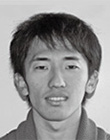
Co-Captain Masahiro Kotani
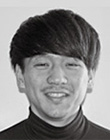
Captain Hiroyuki Fujii
Captain Hiroyuki Fujii / Co-Captain Masahiro Kotani
After the end of the Hakone Ekiden (road relay race held on January 2 and 3), the Ekiden Team of the Chuo University Track and Field Club transitions to new leadership. We followed events transpiring around January 3, which is the turning point for the old and the new.
The captain who will represent the team is determined by mutual election by fourth-year students.
In January, Hiroyuki Fujii (4th-year student in the Faculty of Economics) was quickly elected as captain. His classmates recognized the way in which he had lived and competed for the past three years. The rest of the Chuo University team would follow the example of their new leader when competing in the Hakone Ekiden.
Combination of quiet and dynamic
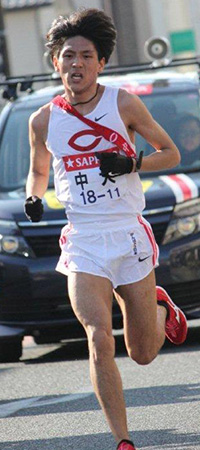
Captain Fujii leads by example with a strong run in the seventh stage of the Hakone Ekiden
There was difficulty deciding on a co-captain. Masahiro Kotani (4th-year student in the Faculty of Economics) broke the silence by raising his hand. To Captain Fujii, it appeared that Kotani was declaring his intention to serve as co-captain.
Kotani had a plan for becoming co-captain. “Since Fujii is quiet, I thought that the co-captain should be someone more talkative.” When compared to a family, the taciturn Fujii is like the father and the caring Kotani is like the mother.
When greeted by younger students at the dormitory entrance in the morning, smiling Kotani responded to the nervous expressions of first-year and second-year students by giving short messages of encouragement. In some cases, he offered advice on training or lifestyle, or just engages in small talk.
“After training, I tried to pick up the spirits of younger runners by giving messages of encouragement,” says Kotani. “I think that doing so would help bring the team together.”
Kotani focused on keeping the team upbeat. He was quick to discover physical injuries or mental uneasiness in early stages and prevent them from becoming serious.
“I tried to keep an eye on how younger runners are doing,” he says. “I had gone through some difficult times myself. I wanted to keep the team unified as we trained for the Hakone Ekiden.”
His daily effort at communication has fostered an atmosphere in which younger students feel comfortable speaking with older students. At the dinner table, the team discusses the day’s events and seems like a warm family.
After the spring track season and the summer camp, October bring the important event of the Hakone Ekiden Preliminaries (Tachikawa).
Captain Fujii was forced to withdraw from the preliminaries due to a leg injury. It was his third consecutive withdrawal, dating back from his second year at university. This left Fujii feeling frustrated. Although he preferred to lead by example, he was unable to compete.
After Chuo University passed the preliminaries in 8th place, Fujii received encouragement from Kotani. “Let’s run together at Hakone,” said Kotani.
Fujii appeared to be recovering from his injury, and his name was listed among the 16 runners on the team entry sheet which was submitted on December 10. However, he was omitted from the list of competing runners when entries for specific stages of the race were submitted on December 29. He had run the third stage when he was a third-year student, and was scheduled to run the third stage again in this year’s race before being forced to withdraw. “I want to compete,” said Fujii. “But I am not physically able.”
“Give everything that you have!”
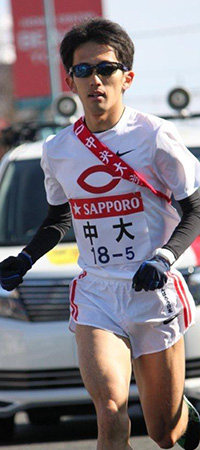
For three consecutive years, Kotani ran the mountainous fifth stage
The first half of the Hakone Ekiden began on the morning of January 2, 2016. Kotani was scheduled to run in the fifth stage and was warming up at the Odawara Relay Point. For the third consecutive year, he would run the mountain-climbing stage of the course. “The fifth stage is one stage that I have always wanted to run since I entered university,” he says.
During his second year, Kotani performed well in practice and earned the right to compete in the Hakone Ekiden. For three years since then, he went on many trial runs and focused on acclimatizing his body to the mountainous course.
When Kotani first competed in the Hakone Ekiden during his second year at university, his goal was to finish the stage. “I wanted to show that I could successfully run the stage,” he says. Ultimately, he was the thirteenth runner to cross the finish line for the first half of the ekiden. During the previous year’s ekiden, the Chuo team had dropped out during the fifth stage. Kotani’s ability to complete the fifth stage was like the return of a missing piece to the team’s puzzle.
In his third year, Kotani ran the fifth stage for the second time and finished in seventh place by improving time by nearly two minutes compared with the previous year. There were great expectations for Kotani’s performance on the mountainous fifth stage during the final official race of his final year at university.
Kotani ate one hour prior to beginning his warm-up. He had decided on the pre-race menu by himself: nutritional jelly, two rice balls, and two pieces of sponge cake. He also made sure that the contents of the rice balls were things that he had eaten before. The time immediately before the race is very important for obtaining peak condition.
Shuhei Suzuki (3rd-year student in the Faculty of Law), who ran the fourth stage for the Chuo team, appeared at the relay point. Kotani thanked him for passing on the sash, expressed his gratitude for the labor of Suzuki, and started the mountainous stage with an elevation difference of 864 meters. During his run, Kotani was troubled by sudden gusts of wind through the mountains. His 162-centimeter, 48-kilogram frame was in danger of being blown away.
At the final downhill stretch of the stage about 300 to 400 meters from the finish line, Coach Haruo Urata gave Kotani a message of encouragement through the microphone of the administrative vehicle driven behind the runners. “Kotani! This is your last Hakone Ekiden! Give everything that you have!”
“Coach Urata was always with me throughout the day of the race, and he watched over me for four entire years,” says Kotani. “I can never express the depths of my gratitude.”
Overwhelmed with emotion, Kotani fell into the arms of his teammates waiting at the finish line. Although he finished in fourteenth place, he was satisfied with his final race.
Overflowing with the joy of running
The morning of January 3 arrived. Due to a substitution which was made that morning, Captain Fujii had been entrusted with the seventh stage.
The night before the race, Fujii had eaten a rice-filled omelet at a casual restaurant. On the day of the race, he had two rice balls and three pieces of sponge cake. His beverages were water or sports drinks. This was the usual menu for Fujii. “This food gives me enough energy for 20 kilometers,” he says. “I don’t want to eat too much.”
The second half of the ekiden started with the sixth stage. As Fujii watched Takumi Tanimoto (3rd-year student in the Faculty of Economics) running down the mountainous course, Fujii could see that Tanimoto was exhausted. Fujii congratulated him on his efforts and patted him on his shoulder. As soon as Tanimoto returned the favor by patting Fujii on his shoulder, Fujii was off and running.
Fujii passed three other runners. “Take it easy on the first half and then pick up the pace on the last half,” directed Coach Urata from the administrative car. His coach’s advice matched Fujii’s own strategy.
Remembering the days during which he had struggled with injury, Fujii’s body overflowed with the joy of running. Perhaps he was running too fast a pace? Again, he heard advice from Coach Urata. “Don’t run using just your thighs. Use your butt and hamstrings, too!”
Fujii ran a strong race and soon sighted the Hiratsuka Relay Point which marked the beginning of the eighth stage. First-year student Takahiro Naemura (Faculty of Literature) was waiting with a tense expression. Long before he passed the sash to Naemura, Fujii was already shouting advice.
“Don’t be nervous!” Fujii shouted. The rookie runner Naemura simply nodded and then began his run. During the seventh stage, Captain Fujii had passed three runners and moved Chuo up to twelfth place. An automatic qualification (top-ten finish) for next year’s Hakone Ekiden was in sight. Fujii had finished in sixth place for the seventh stage. As always, he led by example.
◇
Chuo University finished in fifteenth place and missed an automatic qualification for the fourth consecutive year.
At the reporting session held near the second-half finish line, Captain Fujii burst into tears. The road was lined with fans of Chuo University. Even after the end of the race, ardent fans and supporters were still gathered. “I feel so bad that we were unable to obtain automatic qualification for next year’s race, despite the support of so many fans,” said Fujii, crying his first tears since entering university.
A sash filled with feeling
| Place | University | Hours・Minutes・Seconds |
| 1 | Aoyama Gakuin University | 10・53・25 |
| 2 | Toyo University | 11・0・36 |
| 3 | Komazawa University | 11・4・0 |
| 4 | Waseda University | 11・7・54 |
| 5 | Tokai University | 11・9・44 |
| 6 | Juntendo University | 11・11・24 |
| 7 | Nippon Sport Science University | 11・11・32 |
| 8 | Yamanashi Gakuin University | 11・11・51 |
| 9 | Chuo Gakuin University | 11・13・31 |
| 10 | Teikyo University | 11・15・21 |
| <Universities finishing in the top 10 automatically qualify for next year’s ekiden> | ||
| 11 | Nihon University | 11・16・50 |
| 12 | Josai University | 11・20・6 |
| 13 | Kanagawa University | 11・20・7 |
| 14 | Meiji University | 11・20・39 |
| 15 | Chuo University | 11・21・48 |
| 16 | Takushoku University | 11・23・54 |
| 17 | Tokyo International University | 11・24・0 |
| 18 | Daito Bunka University | 11・28・45 |
| 19 | Hosei University | 11・31・12 |
| 20 | Jobu University | 11・36・46 |
Runners returned to the dormitory on the evening of January 3. The entire team gathered together in the cafeteria for dinner. After the meal, fourth-year students took turns expressing their gratitude and giving advice to younger runners.
A new team would now start led by third-year students. They would begin practicing from the morning of January 4. The fourth-year students gathered together in a room. This ended the time that the fourth-year students would be responsible for monitoring the condition of rooms of the younger students.
The Hakone Ekiden is a nationally-loved event in Japan. The television rating approaches 30% every year. Teams are judged by results. The Chuo runners received both praise and criticism. They responded by gritting their teeth, motivating themselves, and attempting to respond to criticism. Their races were filled with a variety of emotions.
“I tried to communicate with and encourage all runners, from first-year students to fourth-year students,” says Co-Captain Kotani. “Although we failed to achieve the desired results, I am happy with how the team came together.”
“I felt that showing discipline and hard work was the only way to lead the team,” says Captain Fujii. “I developed a strong sense of responsibility.”
The Chuo University Ekiden Team has one traditional gift which is given to the captain only. It is a red sash on which the other runners and coaches have written their names.
Captain Fujii, Co-Captain Kotani and the other fourth-year students stared at the sash, the only of its kind in the world. The sash was filled with the myriad of emotions which the team had shared.
Future of the captains
Fujii will continue to compete in track and field as a member of a corporate sports team. Kotani will enter employment at an automaker. In the future, he hopes to become an international business man who works overseas. “Just like with running, I will persevere through the challenges to come,” he says.
Eating two main meals?!
Every runner has a different strategy for eating before the race. A team official revealed that some runners will eat two main meals, such as pasta and a rice-filled omelet together. From small eaters to big eaters, runners select their optimal menu and amount based on experience.
~Reflection on reporting~
Don’t look down! Look up!
Shunsuke Yamada (3rd-year student in the Faculty of Law)
Student Reporter
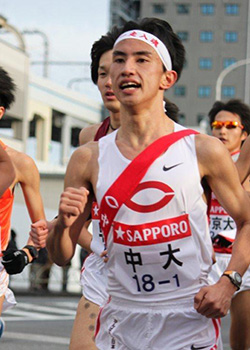
Machizawa ran a strong race and finished the first stage in fourth place
“When we were students, we didn’t have anything. But we still won!”
Surprised by the angry voice which I heard from behind me, I turned around. It was a little after 2:30 pm on January 3. I was in Tokiwabashi Park in a business neighborhood close to the finish line for the second half of the Hakone Ekiden in Otemachi, Tokyo. The park is famous for its status of Eiichi Shibusawa, a pioneer in corporate management. A reporting session for the Chuo University Track and Field Club was being held in the park.
After finishing the two-day race, the Chuo runners were being subjected to harsh criticism. The owner of the angry voice sounded like an older man. Perhaps he was an alumnus of Chuo University or a passionate fan. When he talked about winning, perhaps he was referring to the six consecutive victories which Chuo University achieved until 1964. Current members of the Chuo University Ekiden Team stood in one line facing fans. All of the runners hung their heads.
After passing through the preliminaries to compete in the Hakone Ekiden for a record ninetieth time, the team had finished in fifteenth place. For the fourth consecutive year, they had failed to automatically qualify for the next year’s ekiden. Moreover, they finished nearly thirty minutes behind the time posted by Aoyama Gakuin University, which had won the overall championship for the second consecutive year.
I had nervously watched the first half of the Hakone Ekiden on television while holding my smartphone in hand to get flash reports. Taiga Machizawa (3rd-year student in the Faculty of Law) had been entrusted with running the first stage for the second consecutive year. Machizawa ran a strong race and finished among the group of lead runners.
Everyone is now familiar with Machizawa wearing a white headband bearing the phrase “all spirit for running.” At one point during the race, Machizawa had moved out in front of the other leaders. He had sole possession of television screens across Japan.
When he passed the traditional sash, Machizawa was the fourth runner across the finish line. This was a great improvement from his tenth-place finish for the same stage during the previous year’s race. He also improved his time for the stage by 41 seconds. He clearly showed that he had become a stronger runner.
I was enthralled by the aggressiveness which Machizawa showed when running.
I watched the second half of the Hakone Ekiden from near the final finish line. I saw Chuo runners who had given every ounce of their effort in an attempt to capture automatic qualification for next year’s ekiden. I was trembling with pride at being a Chuo University student.
I work together with Machizawa at my part-time job. I was struck by how politely he greeted and seemed almost hesitant to speak. He doesn’t seem like the type to lead a team.
On the day prior to preliminaries (Tachikawa) held in last October, Machizawa was scheduled to work a shift at our job. He made sure that he found someone to cover his shift and was careful not to inconvenience others. He did all of this while preparing his condition for the race.
Immediately after Chuo University passed the preliminaries and secured a place at the Hakone Ekiden, I received countless Line messages about Machizawa from people at my job.
Machizawa also sent Line message thanking everyone for their support. His message included a unique stamp which clearly expressed his happiness and relief.
As the Hakone Ekiden drew near, someone placed ekiden magazines and Chuo sports newspapers on a desk at my part-time job. All of the covers featured a familiar runner wearing a white headband. “I also look like I am in agony when I am running,” said Machizawa in embarrassment, while watching these covers and newspapers.
Returning to the scene in Tokiwabashi Park on January 3, sharp words were directed at the despondent-looking runners. “Don’t look down! Look up! You’ve got to face what’s ahead!” It seemed that old fans were encouraging runners to use their disappointment to inspire them at next year’s ekiden.
A few days after the Hakone Ekiden, I met Machizawa. Speaking from the heart, I congratulated him on his hard work and told him how thrilled I was by the race. Once again, Machizawa appeared embarrassed. When seen at his part-time job or in the classroom, Machizawa seems like an ordinary student.
“People often tell me that I seem like a completely different person when I am competing,” he says. “Anyway, I’m going to have to face even bigger expectations next year after the current fourth-year students graduate. It’s going to be tough.”
As he suddenly said these words, the face of the “headband runner” transformed into the face of “Machizawa, ace runner of Chuo University.”
- Research Activities as a Member of Research Fellowship for Young Scientists (DC1), Japan Society for the Promotion of Science (JSPS) Shuma Tsurumi
- Important Factors for Innovation in Payment Services Nobuhiko Sugiura
- Beyond the Concepts of Fellow Citizens and Foreigners— To Achieve SDGs Goal 10 “Reduce Inequality Within and Among Countries” Rika Lee
- Diary of Struggles in Cambodia Fumie Fukuoka
- How Can We Measure Learning Ability?
—Analysis of a Competency Self-Assessment Questionnaire— Yu Saito / Yoko Neha - The Making of the Movie Kirakira Megane








